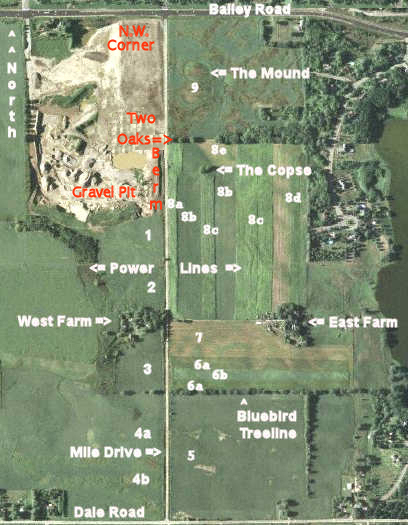
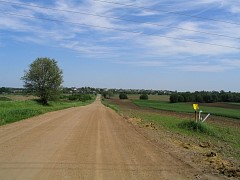 It's late spring, there has not been an abundance of rain, but it's a green landscape
nonetheless.
It's late spring, there has not been an abundance of rain, but it's a green landscape
nonetheless.
|
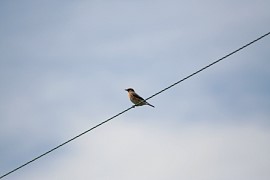 Eastern Bluebird (Sialia sialis) populations declined in recent years to as low
as 17 percent of their
previous numbers in the late 1950s and early 1960s. Reasons postulated for this decline
include severe winters, harmful effects from the use of pesticides to control fire ants,
and competition with other hole nesters for increasingly scarce nest sites.
Eastern Bluebird (Sialia sialis) populations declined in recent years to as low
as 17 percent of their
previous numbers in the late 1950s and early 1960s. Reasons postulated for this decline
include severe winters, harmful effects from the use of pesticides to control fire ants,
and competition with other hole nesters for increasingly scarce nest sites.
|
|
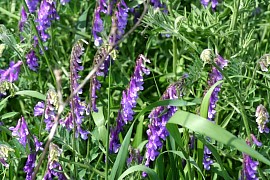
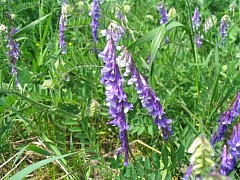
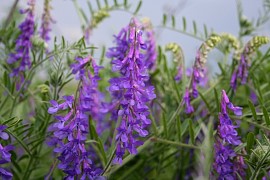
|
|
Hairy Vetch (Vicia villosa Roth) is very similar to Tufted Vetch, the most noticeable
difference being that Tufted Vetch has a smooth stem.
Both are fast-growing and flower prolifically, sending out one-sided racemes of cascading
pea-flower shaped purple to violet flowers from the leaf axil during its late spring to late
summer flowering period.
Hairy Vetch is widely used as a forage crop for cattle, and is beneficial to other plants because,
like other leguminous plants, it enriches the soil in which it grows by its nitrogen-fixing
properties. Hairy Vetch is also much appreciated by bees and butterflies as a source of nectar.
The plant may also be used to curb erosion.
Return to Flora
|
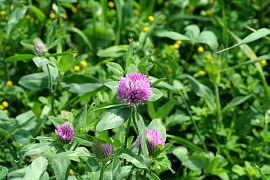
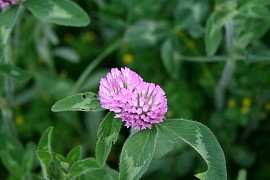
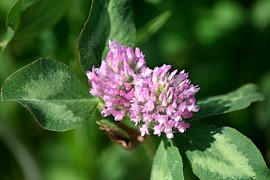
|
|
Red Clover (Trifolium pratense) was imported from Europe. Bumblebees and honey bees are attracted
to the honey scent and nectar of red clover; red clover produces a honey but far less than white clover.
Like white clover, one may find lucky four leaf red clover.
Return to Flora
|
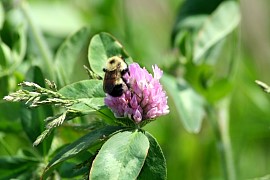
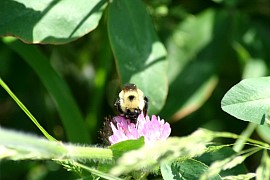
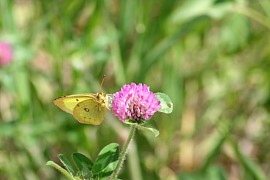
|
|
In the pictures above you can see insects attracted to red clover. Above left and center is
a Bumble Bee (Bombus hortorum). There are over 50 types of bumble bee in North America.
Because they live in small nests bumble bees never swarm.
Bumble bees do not produce enough honey for commercial use, just a few grams at a time to feed their young.
Unlike the honey bee the humble bumble is gentle and slow and much less aggressive.
In the first warm days of Spring you may see the large queens flying busily about the early bulbs and
flowers. These large slow bees are searching for nectar and pollen to turn into honey and food for their
newly hatching brood. Because of its weight, bumblebees can gather nectar and pollinate some
flowers other varieties of bee can't.
As soon as the queen produces worker bees they begin work to support the colony and their queen.
She continues to lay eggs but as it takes more and more of her time the pollen and nectar collection
is delegated to the workers, the queen spending her whole time in the nest.
The bumblebee is able to defend itself and it's nest by stinging intruders many times without
losing it's stinger and eventually dying. The bumblebee is able to sting more than once because
it has a smooth stinger - which allows for easy extraction - while a honeybee's stinger has barbs
that stick into it's victim. The stinger is detached from its body when the honeybee attempts
to fly away, which leads to the bee's death.
The butterfly in the picture above right is a Cloudless Sulphur (Phoebis sennae).
It is a member of a butterfly family that contains over 4,700 members.
Quite common in the summer, members of this family many be the most abundant species of butterfly on
earth. They fly in a seemingly haphazard way and feed primarily on plants in the mustard and clover
families. Both sexes have two small silver spots on the underside of their hind wings.
|
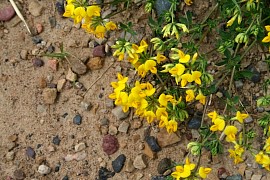
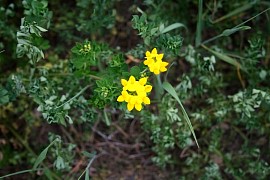
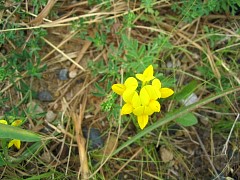
|
|
Birds Foot Trefoil - (Lotus corniculatus).
A perennial member of the bean (Legume) family native and widespread in Europe
(except the extreme North),Asia, North Africa; introduced to North America and Canada.
It's common name derives from the shape of its black seed pod
which when mature looks like the claw foot of a bird. All sorts of wildlife eat both the seeds and the plant foliage
of this plant. The list includes deer, turkey, quail, mourning dove, ducks, rabbits, and cattle .
Return to Flora
|
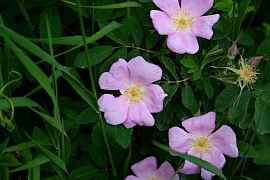
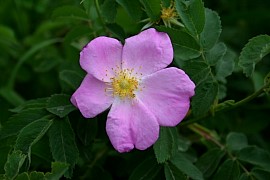
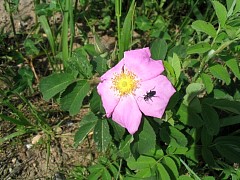
|
|
The Wild Prairie Rose, (Rosa arkansana). The name Rosa arkansana comes from the Arkansas River in Colorado.
Low Prairie Rose is an example of a shrub that has adapted to the regular occurrences of fire and heavy
grazing on the prairies.
Return to Flora
|
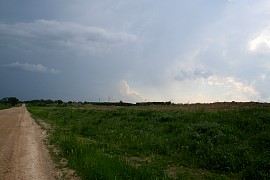
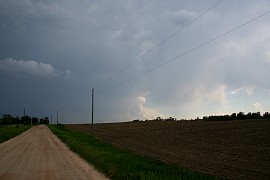
Far left: I start down the gravel road with some bad weather rolling in. I made
the turn at the south end of Mile Drive without getting rained on.
|
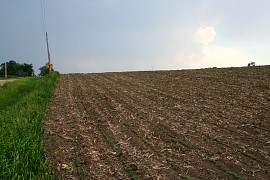
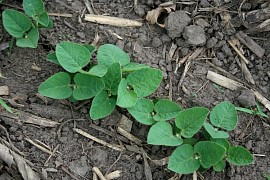
In Field #4 broadleaf soybean plants are coming up.
Soybeans have cotyledons.
They look like leaves and they are the first plant part you see when a seedling
pokes its head out of the ground. Cotyledons help keep the new seedling
fed until it can make its own food. Sometimes cotyledons are called seed leaves.
The first leaves to develop are the single leaves.
Two of these single leaves appear directly opposite one another above the cotyledons.
|
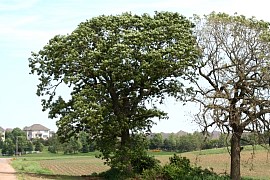
For some reason the eastern-most tree of Two Oaks hasn't leafed out as quickly as it's neighbor.
Perhaps it's not as healthy.
|
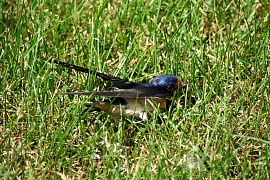
Here is a baby bird fallen or kicked out of the nest. I hope no predator got it.
Look at the brown on the face - it's a baby Barn Swallow, not an Eastern Bluebird.
Return to Birds
|
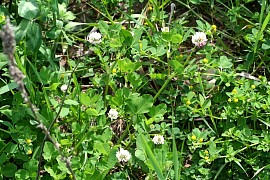
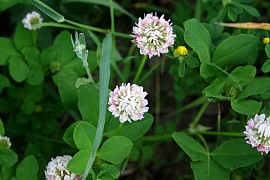
Alsike clover (Trifolium hybridum), a member of the pea family, has flowers which are
usually pink and white in color but
can be darker depending
on growing conditions. The flower stem originates from the same point off the main stalk
as separate leaflet stems.
Hay or pasture containing a large percentage of wet alsike clover is generally not recommended for horses.
Alsike clovers may contain some compound, possibly an alkaloid, which causes
liver dysfunction. If this cirrhosis of the liver is allowed to continue, death may result.
Some horses may die within 24 hours of alsike consumption.
Return to Flora
|
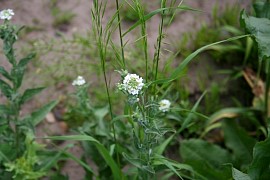
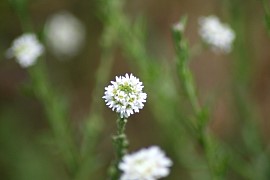
Hoary Alyssum (Berteroa incana) is a native plant found throughout the United States,
except in the southern states.
The stems, leaves, and seed pods are covered with rough, grayish-green star-shaped hairs.
These hairs give the plant a pale green coloration. The name hoary denoted the rough
hairs on the stems, leaves, and fruit.
Return to Flora
|
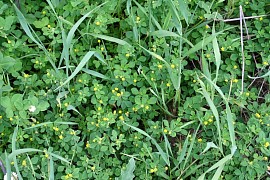
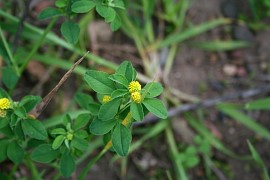
Black medick (Medicago lupulina), also known as Black Nonesuch, Hop Medick, or Yellow Trefoil.
It is closely related to alfalfa, and was introduced from western Asia, eastern Europe, and north Africa.
It's a common garden weed that's hard to pull from the ground.
Return to Flora
|